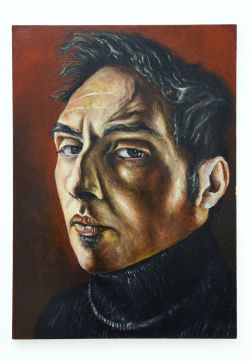PALEOCRIO
March 28 | April 2 - 11.00 | 1.00 AM – 16.30 | 8.00 PM
Paleocrio's work is the result of a complex synthesis of symbolism, living matter and tradition, meant in the most esoteric and intimate possible way.
The event-exhibition presented by 28 Piazza di Pietra Fine Art Gallery, curated by Francesca Anfosso and organized by ComediArting, exhibits mostly unpublished paintings exploring the theme of collective subconscious with a special sensitivity for eating disorders (ED).
The reason for this connection has its roots in the distinctive strong symbolism of Paleocrio’s work and in his long-time research on psychoanalytic topics moved by an even cathartic and therapeutic will.
When we talk about a symbol, we hit a rock of contradictions and paradoxes, that if not understood, can become an eschatological trap set by the subconscious. Lacking alternative tools, Art, in its limited drive towards utilitarianism, makes the enigma of symbols graspable through sensory perception, which is not and will never be limited to the simple act of looking.
Being tangible just like an external trauma, Art can catalyze pain, showing its meaning while turning distress into something useful. Hidden trauma, however, will appear in symbols - the ultimate carrier - capable of revealing the arcane and certainly collective root of the deepest human suffering.
Art, therefore, will reach onto us through an “expansion” that will lead us to pleasure. The Symbolism hidden in It will gather every sorrow with clarity so that pain can be seen, understood and made, perhaps, vain.
This link between art, pain and the hope of overcoming it, summarized in the symbol, also finds expression in the words contained in the catalog that Professor Leonardo Mendolicchio, psychiatrist expert in ED, dedicates to the artist: <<Art wouldn’t be art if it didn’t challenge the time it represents, art must necessarily be a tool for observing the world we live from an unprecedented “perspective”. In Paleocrio’s fullness there is a difference with the “surplus” of the consumer society: while that society hands out “objects” of consumption, our artist instead, gives us pure symbols. What is the power of the “symbol” that finds the most sublime of vehicles in art? The ability to provide meaning without ever satiating people. The symbol nourishes without suffocating, without gorging, without saturating. At its best the symbol in art can take to an “elsewhere” keeping the individual hanging on a question that will revive rather than clouding as the object of consumption would do.>>
The works on display are therefore creative tools to interpret and understand the sense of pain, even of a person affected by ED, but not only that. They are also a really living part of the experiment, since all the works presented both in the exhibition and in the catalog published for the occasion (Pandion ed.), were created using ancient techniques, mainly linked to the Italian Renaissance, with the desire to recover and the ability to revive, through an inner search made of creative images, a sacred sense of beauty.
Paleocrio, born Leonardo Caprio, lives and works in Rome.
At the end of the exhibition, there will be a meeting and talk-show on art and psyche coordinated by the Curator and Historian of Art Gina Ingrassia with the artist Paleocrio and Prof. Leonardo Mendolicchio.








